Day 1 of a three day long weekend of Early Winter Tours today. The flipside of waking up to a cold, crisp and frosty morning was that we enjoyed blue skies and sunshine during the day, great weather to be out birding.
Our destination for the day was NE Norfolk. On our way east along the coast road this morning, we passed through Stiffkey. The cows are still out on the wet meadow just to the east of the village and we managed to pull up and scan the grass from the car. We were looking towards the morning sun, low in the sky, but still it didn’t take long to spot a Cattle Egret in with the cattle, a nice way to start the day. There are two here at the moment, and they have been lingering here for some time now, but it is always worth a stop to look at them.
As a couple of cars appeared down the road behind us, we had to move on. We managed to see some other things on our journey though. As we passed through Cley, a big group of Curlew flew across the road in front of us and landed in the winter wheat on the other side where they started feeding. We could see several skeins of Pink-footed Geese making their way inland as we headed towards Sheringham.
Passing Cromer, we decided to have a quick look through the gulls down by the pier. There has been a Caspian Gull or two here in recent weeks, though they can be a bit erratic in their appearances. As we got down onto the Prom, we could see a group of gulls loafing on the rocks away to the west. They were rather distant, but looking through them with the scope, we couldn’t see anything unusual with them.
Out to sea, a small crab boat was tending to its pots and a large mob of gulls was following behind. We had a quick look through those too, but all we could see were Herring Gulls and Great Black-backed Gulls. A couple of Red-throated Divers flew east offshore and a Cormorant flew past heading west.
There are normally a few gulls on the beach by the pier but someone was walking his dog there today and just a handful of Herring Gulls were just offshore, waiting for him to leave. There was no sign of the Caspian Gull which is often here. The crab boat had finished its work and moved on, but we could still see lots of gulls on the sea further out. Another careful scan through and this time we managed to find a juvenile Glaucous Gull in with them. Great – one of the birds we had hoped to see this weekend. One had been reported flying off west from Sidestrand earlier, so this was possibly the same bird.
The gulls were just loafing on the sea now, with the prospect of food having departed with the crab boat, and the Glaucous Gull started to have a quick bathe. The sea looked fairly calm but there was still enough swell for the gulls to disappear in the waves. Still, we managed to get it in the scope and get a good look at it. We could see it was a rather uniform dark biscuit colour with paler wing tips. Even at that distance, we could see the distinctive black-tipped pink-based bill as it caught the morning sun.
 Turnstone – several were around the picnic tables on the pier
Turnstone – several were around the picnic tables on the pier
We were right by the pier so we figured we would get a slightly closer view of the gulls from out on the end. Unfortunately, by the time we got out there the gulls had mostly dispersed and there was no further sign of the Glaucous Gull. However, we did get a good look at several Turnstones which were looking for scraps around the picnic tables outside the cafe on the pier.
It was then a rather slow drive along the winding coast road to Happisburgh. We parked in the car park by the lighthouse and set off down the coast path along the top of the cliffs. The winter wheat field here has been home to a group of Shorelarks in recent weeks and we were hoping to see them. But as we walked beside it, there were few birds present beyond a scattering of Black-headed Gulls. A couple of Gannets flew past offshore.
As we got towards the south end of the field, we met a couple of birders coming back the other way who told us that four Shorelarks had earlier been down on the beach but had flown up and out across the field. We stopped and had a good scan, but there was still no sign of them, so we continued on to the end. We could see a muck spreader haring up and down the next field inland and it put up a large group of Skylarks ahead of it. While we were scanning over in that direction, we heard Shorelarks calling and someone shouted to say they had dropped back down on the beach.
From the top of the cliffs, we could see two Shorelarks now picking their way along the high tide line. We got them in the scope and had a good look at them, their bright yellow faces glowing in the morning sunshine. They worked their way along, picking at the dead vegetation left behind by the sea, before turning round and coming back towards us. Even better, they then decided to run across the sand towards us, looking for food at the base of the cliffs, right below us. Great views!
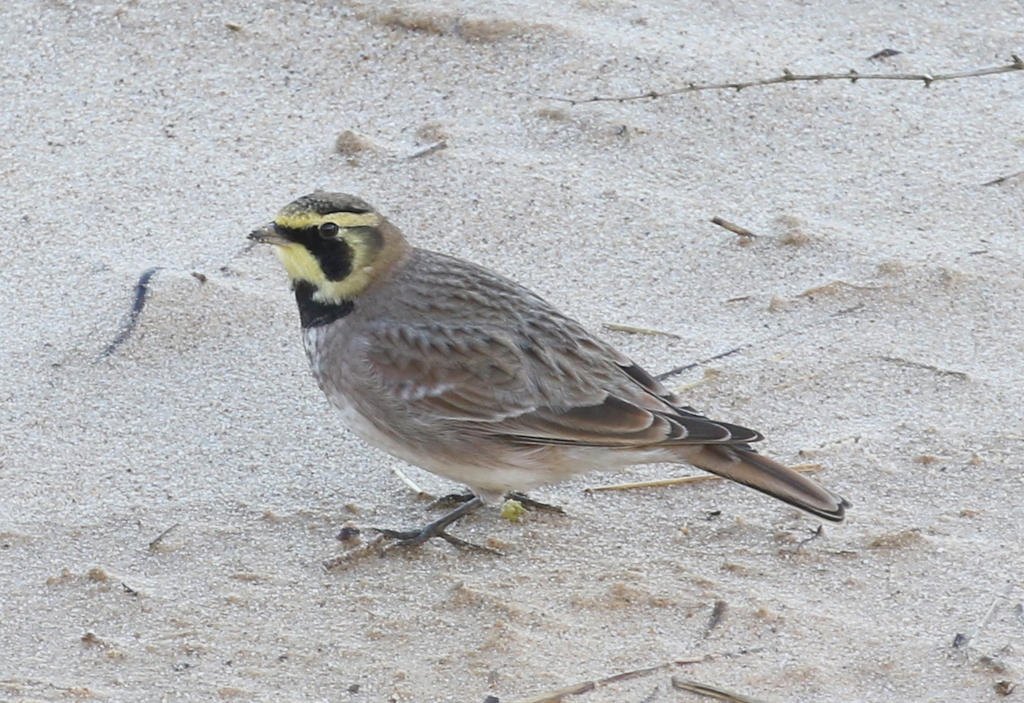 Shorelark – one of two feeding on the beach below us
Shorelark – one of two feeding on the beach below us
A Meadow Pipit flew in to join the two Shorelarks but it was quickly spooked by a dogwalker out on the beach and flew off, taking the Shorelarks with it. They were quickly replaced with a small flock of eleven Snow Buntings which flew in and landed on the tide line, where the Shorelarks had earlier been feeding. We got the Snow Buntings in the scope and watched them as they picked their way along the vegetation, before flying off back up the beach.
The Snow Buntings have been feeding on some seedy weeds at the base of the cliffs, so on our way back we had a look for them – carefully, not getting too close to the edge as the cliffs here are rather unstable! The Snow Buntings we had just seen had joined up with another group and we found them just where we had expected. There were at least 25 now, and we had a great look at them feeding just below us. There was a noticeable mix of paler and darker birds, a mixture of two races from Scandinavia and Iceland respectively.
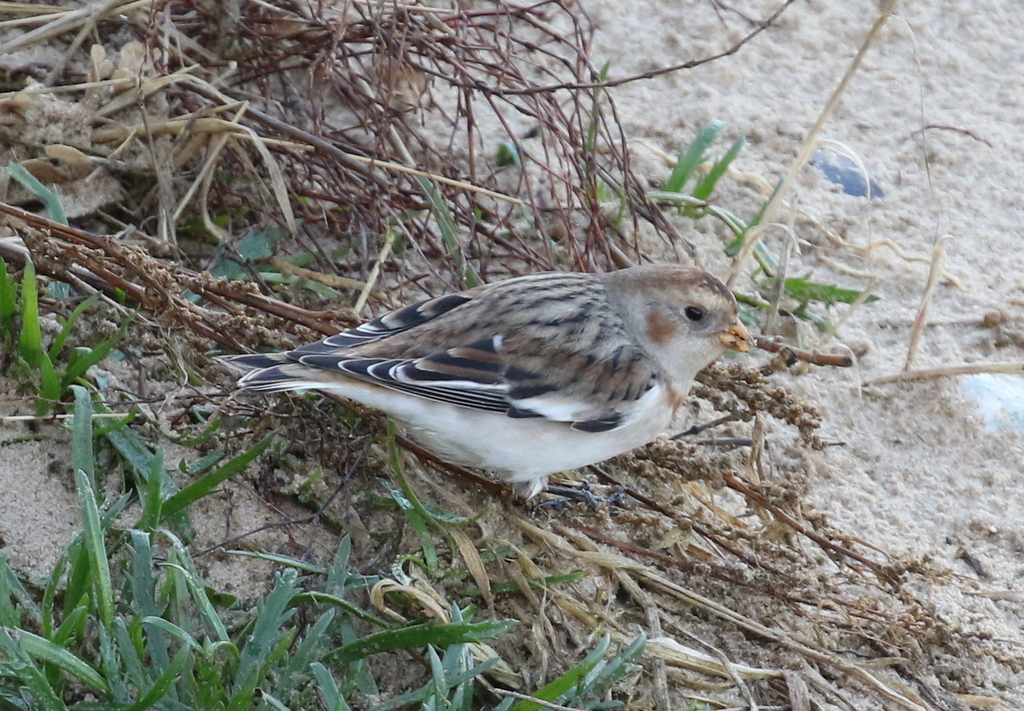 Snow Bunting – one of about twenty five on the beach today
Snow Bunting – one of about twenty five on the beach today
Having successfully caught up with the two species we had hoped to see here, we made our way back across country to Felbrigg Hall. We had lunch at one of the rather rustic picnic tables in the car park. The trees here can hold a nice variety of woodland birds at times but it was rather quiet here today.
After lunch, we set off to walk up to the Hall. A couple of Goldcrests flew across the road in front of us and disappeared into a holly tree. As we passed by a small pond we could hear Long-tailed Tits calling and looked across to see them feeding in the brambles by the water. There were Great Tits, Coal Tit and another Goldcrest in the trees too.
This autumn saw a massive arrival of Hawfinches, coming to the UK from the continent. Where exactly they have come from and why is still not entirely clear, but some of them have taken up temporary residence in suitable areas across the country, including a small number in Felbrigg Park. They have been rather mobile, but have been seen most often in the trees by the Orangery, which is where we found a small expectant crowd waiting for them.
Thankfully we didn’t have to wait too long before a Hawfinch flew in. It went back and forth a couple of times over the wood, flashing its bold white wing flashes, before landing in the top of one of the trees. We got it in the scope and could see its huge nutcracker of a bill. A second Hawfinch flew in and joined it, before the two of them dropped down out of view, possibly to feed on the berries in a yew tree.
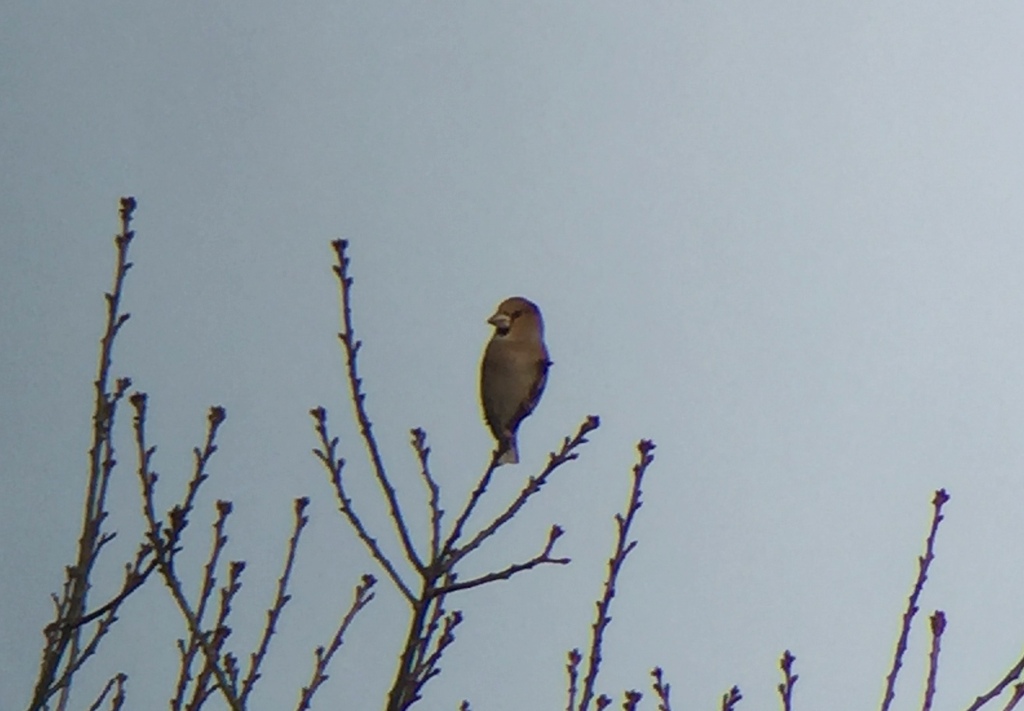 Hawfinch – two flew in and landed in the trees by the Orangery
Hawfinch – two flew in and landed in the trees by the Orangery
There were a few other birds around the house too. A Mistle Thrush flew out of one of the yews and away across the grass. A couple of Siskins flew over our heads calling, as did two Chaffinches. A Pied Wagtail was catching insects around the chimneys on the roof of the house.
We had been lucky that we did not have to wait too long to see the Hawfinches, so we decided to make the most of our time and move on to have a look down at the lake. We hadn’t gone more than about fifty metres when another Hawfinch flew in and landed in the trees in front of us. We just had time to get it in the scope before it flew off again. A Jay was hiding in the trees by the gate but flew off as we approached.
As we walked down past the wet meadows above the lake, a tight group of Teal wheeled round several times before eventually landing down on the water. There was a family of Mute Swans and a few Greylag Geese down on here too. We had a careful look to see if we could find a Common Snipe in the grass by the water but we couldn’t see one at first. Only when we had carried on down towards the lake did one of the group look back and spot a Common Snipe feeding surreptitiously in the grass.
There were more ducks out on the lake – lots of Mallard and Gadwall, a few Wigeon and three Tufted Ducks. We could hear Siskin calling and looked across to see a group fly up out of the alders on the other side of the reeds and disappear back over the trees. It is a nice walk around the lake here, but with the evenings drawing in quickly these days we decided to move on and make the most of the afternoon.
On our way back west, we stopped in Sheringham and walked down to the Prom. Our main target was Purple Sandpiper – there are usually a few which spend the winter on the sea defences here. However, as we got down to the edge of the beach and scanned the sea, we spotted a pale gull flying around the sea defences a short distance to the west. It was an Iceland Gull, a juvenile. It disappeared behind one of the shelters on the Prom, so we set off in pursuit.
When we got round to the other side of the shelter we could see the Iceland Gull now having landed on the rocks a bit further along with a few Herring Gulls. We stopped and had a quick look at it through binoculars. It was noticeably paler than the Herring Gulls, a pale biscuit colour with paler wingtips, like the Glaucous Gull we had seen earlier. However, it was a much daintier bird, not bigger than the Herring Gulls, quite long-winged in appearance and with a mostly dark bill. We had been very lucky to see both Glaucous Gull and Iceland Gull today!
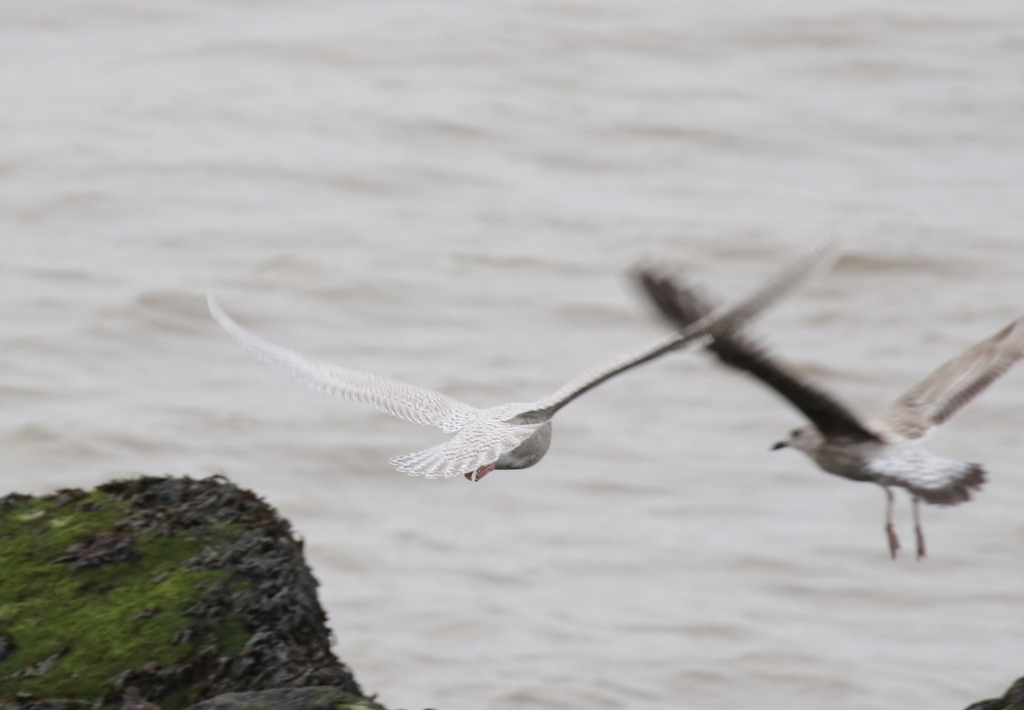 Iceland Gull – flushed by people on the sea defences as we approached
Iceland Gull – flushed by people on the sea defences as we approached
We hurried on round the prom to where the Iceland Gull was on the rocks below, but as we came round the corner we saw a couple carrying their toddler down the steps right by the rocks. As they proceeded to jump up and down in front of the sea, standing on the steps, the Iceland Gull decided it had seen enough and took off. The Herring Gulls simply flew along a little further and landed on the beach, but the Iceland Gull continued on west until we lost it from view.
Our journey along the Prom to here wasn’t entirely in vain though. As we looked down onto the rocks right below where we were standing, a Purple Sandpiper climbed out! It proceeded to walk around on the faces of the large boulders, picking at the seaweed occasionally, giving us a great up close look at it. Then with the couple with the toddler having moved on, the Purple Sandpiper flew out onto the rocks with the Turnstones, where the Iceland Gull had just been.
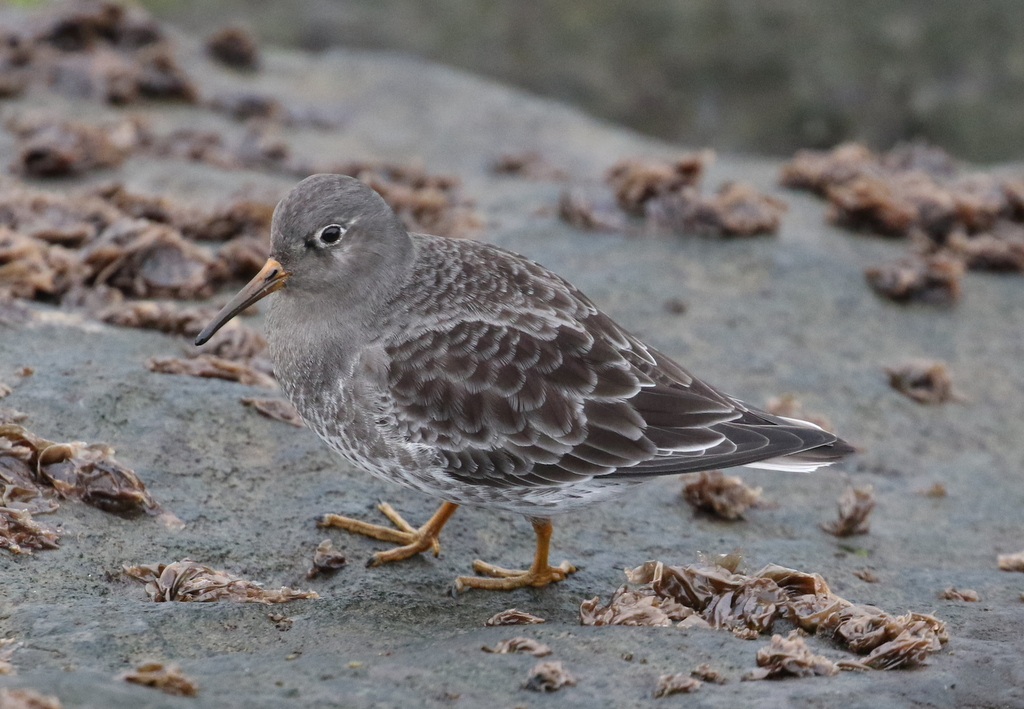 Purple Sandpiper – feeding on the sea defences at Sheringham
Purple Sandpiper – feeding on the sea defences at Sheringham
Having found our main target species here, we returned to the car and continued on our way west. A large flock of Pink-footed Geese were loafing in a winter wheat field by the coast road. We managed to pull up and have a look at them from the car, but there was nowhere convenient to stop. A few miles on, we saw more skeins of Pink-footed Geese flying in and we watched from a layby as they dropped down into a recently harvested sugar beet field to feed.
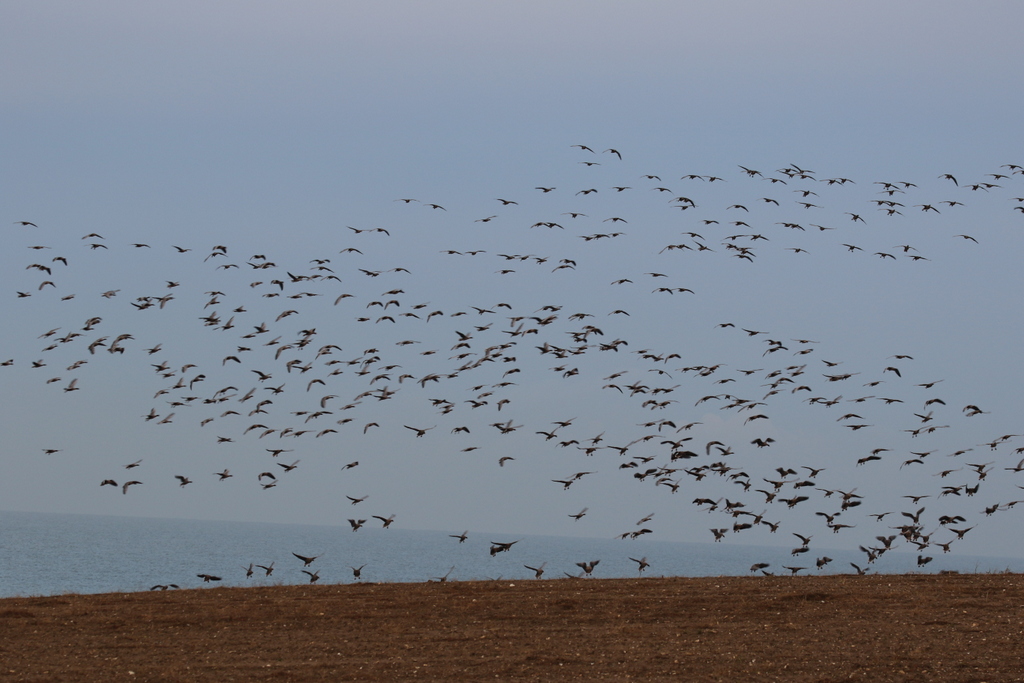 Pink-footed Geese – dropping into a recently harvested sugar beet field
Pink-footed Geese – dropping into a recently harvested sugar beet field
The light was starting to go now, but we thought we would try our luck with a quick diversion down the Beach Road at Cley, to see if we could find the Black Brant which has been feeding here. There was no sign of any Brent Geese in the fields at first, but then we spotted a group flying over the Eye Field and they landed down in the grass. They were quickly joined by another couple of small groups and it felt like we might be in luck, with the geese perhaps having a last feed before heading off to roost.
We climbed up onto the West Bank for a better look. Unfortunately, there was no sign of the Black Brant with them. There were several hundred geese now but this was only part of the flock of Dark-bellied Brent Geese which has been feeding here. No more geese flew in to join them – presumably the rest had already gone off to roost.
 Dark-bellied Brent Geese – part of the flock, feeding along Beach Road
Dark-bellied Brent Geese – part of the flock, feeding along Beach Road
Still, we spent an enjoyable 20 minutes or so here, enjoying the comings and goings at the end of the day. There were lots of Wigeon feeding out on the grass. Further back, we spotted a pair of Pintail on one of the pools and a single drake Shoveler with some Teal on another. A small group of Golden Plover flew up and whirled around repeatedly over the Eye Field calling plaintively. Several Redshanks called noisily from the saltmarsh the other side of the bank. A couple of Water Rails squealed from the reeds.
The Marsh Harriers were gathering to roost now. We could already see at least five out over the main reedbed, flying round or perched in the bushes in the reeds. While we stood on the West Bank, another two Marsh Harriers flew in from Blakeney Freshes, past us and out towards the reserve. Then a Barn Owl appeared, over the bank the other side of the Glaven channel. It flew up and down a couple of times before dropping down into the grass out of view.
When the Brent Geese decided it was finally time to stop feeding and head off to roost, taking off and flying right over our heads with a whoosh of wingbeats, we decided it was time to call it a day too.
















